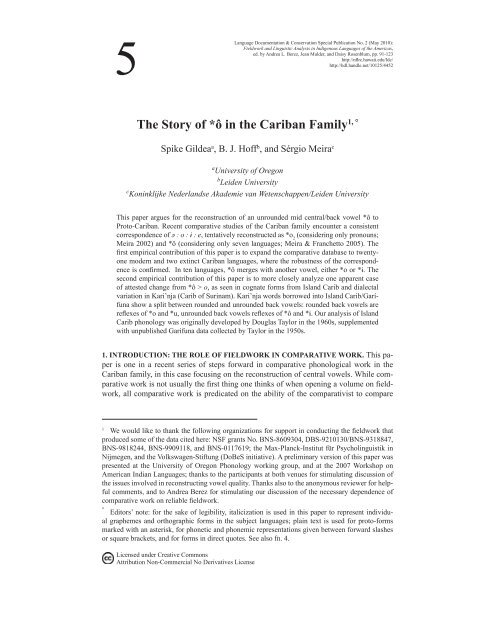Fieldwork and Linguistic Analysis in Indigenous ... - ScholarSpace
Fieldwork and Linguistic Analysis in Indigenous ... - ScholarSpace
Fieldwork and Linguistic Analysis in Indigenous ... - ScholarSpace
You also want an ePaper? Increase the reach of your titles
YUMPU automatically turns print PDFs into web optimized ePapers that Google loves.
5<br />
Language Documentation & Conservation Special Publication No. 2 (May 2010):<br />
<strong>Fieldwork</strong> <strong>and</strong> <strong>L<strong>in</strong>guistic</strong> <strong>Analysis</strong> <strong>in</strong> <strong>Indigenous</strong> Languages of the Americas,<br />
ed. by Andrea L. Berez, Jean Mulder, <strong>and</strong> Daisy Rosenblum, pp. 91-123<br />
http://nflrc.hawaii.edu/ldc/<br />
http://hdl.h<strong>and</strong>le.net/10125/4452<br />
1, °<br />
The Story of *ô <strong>in</strong> the Cariban Family<br />
Spike Gildea a , B. J. Hoff b , <strong>and</strong> Sérgio Meira c<br />
aUniversity of Oregon<br />
bLeiden University<br />
cKon<strong>in</strong>klijke Nederl<strong>and</strong>se Akademie van Wetenschappen/Leiden University<br />
This paper argues for the reconstruction of an unrounded mid central/back vowel *ô to<br />
Proto-Cariban. Recent comparative studies of the Cariban family encounter a consistent<br />
correspondence of ə : o : ɨ : e, tentatively reconstructed as *o 2 (consider<strong>in</strong>g only pronouns;<br />
Meira 2002) <strong>and</strong> *ô (consider<strong>in</strong>g only seven languages; Meira & Franchetto 2005). The<br />
first empirical contribution of this paper is to exp<strong>and</strong> the comparative database to twentyone<br />
modern <strong>and</strong> two ext<strong>in</strong>ct Cariban languages, where the robustness of the correspondence<br />
is confirmed. In ten languages, *ô merges with another vowel, either *o or *ɨ. The<br />
second empirical contribution of this paper is to more closely analyze one apparent case<br />
of attested change from *ô > o, as seen <strong>in</strong> cognate forms from Isl<strong>and</strong> Carib <strong>and</strong> dialectal<br />
variation <strong>in</strong> Kari’nja (Carib of Sur<strong>in</strong>am). Kari’nja words borrowed <strong>in</strong>to Isl<strong>and</strong> Carib/Garífuna<br />
show a split between rounded <strong>and</strong> unrounded back vowels: rounded back vowels are<br />
reflexes of *o <strong>and</strong> *u, unrounded back vowels reflexes of *ô <strong>and</strong> *ɨ. Our analysis of Isl<strong>and</strong><br />
Carib phonology was orig<strong>in</strong>ally developed by Douglas Taylor <strong>in</strong> the 1960s, supplemented<br />
with unpublished Garifuna data collected by Taylor <strong>in</strong> the 1950s.<br />
1. INTRODUCTION: THE ROLE OF FIELDWORK IN COMPARATIVE WORK. This paper<br />
is one <strong>in</strong> a recent series of steps forward <strong>in</strong> comparative phonological work <strong>in</strong> the<br />
Cariban family, <strong>in</strong> this case focus<strong>in</strong>g on the reconstruction of central vowels. While comparative<br />
work is not usually the first th<strong>in</strong>g one th<strong>in</strong>ks of when open<strong>in</strong>g a volume on fieldwork,<br />
all comparative work is predicated on the ability of the comparativist to compare<br />
1 We would like to thank the follow<strong>in</strong>g organizations for support <strong>in</strong> conduct<strong>in</strong>g the fieldwork that<br />
produced some of the data cited here: NSF grants No. BNS-8609304, DBS-9210130/BNS-9318847,<br />
BNS-9818244, BNS-9909118, <strong>and</strong> BNS-0117619; the Max-Planck-Institut für Psychol<strong>in</strong>guistik <strong>in</strong><br />
Nijmegen, <strong>and</strong> the Volkswagen-Stiftung (DoBeS <strong>in</strong>itiative). A prelim<strong>in</strong>ary version of this paper was<br />
presented at the University of Oregon Phonology work<strong>in</strong>g group, <strong>and</strong> at the 2007 Workshop on<br />
American Indian Languages; thanks to the participants at both venues for stimulat<strong>in</strong>g discussion of<br />
the issues <strong>in</strong>volved <strong>in</strong> reconstruct<strong>in</strong>g vowel quality. Thanks also to the anonymous reviewer for helpful<br />
comments, <strong>and</strong> to Andrea Berez for stimulat<strong>in</strong>g our discussion of the necessary dependence of<br />
comparative work on reliable fieldwork.<br />
° Editors’ note: for the sake of legibility, italicization is used <strong>in</strong> this paper to represent <strong>in</strong>dividual<br />
graphemes <strong>and</strong> orthographic forms <strong>in</strong> the subject languages; pla<strong>in</strong> text is used for proto-forms<br />
marked with an asterisk, for phonetic <strong>and</strong> phonemic representations given between forward slashes<br />
or square brackets, <strong>and</strong> for forms <strong>in</strong> direct quotes. See also fn. 4.<br />
Licensed under Creative Commons<br />
Attribution Non-Commercial No Derivatives License

















